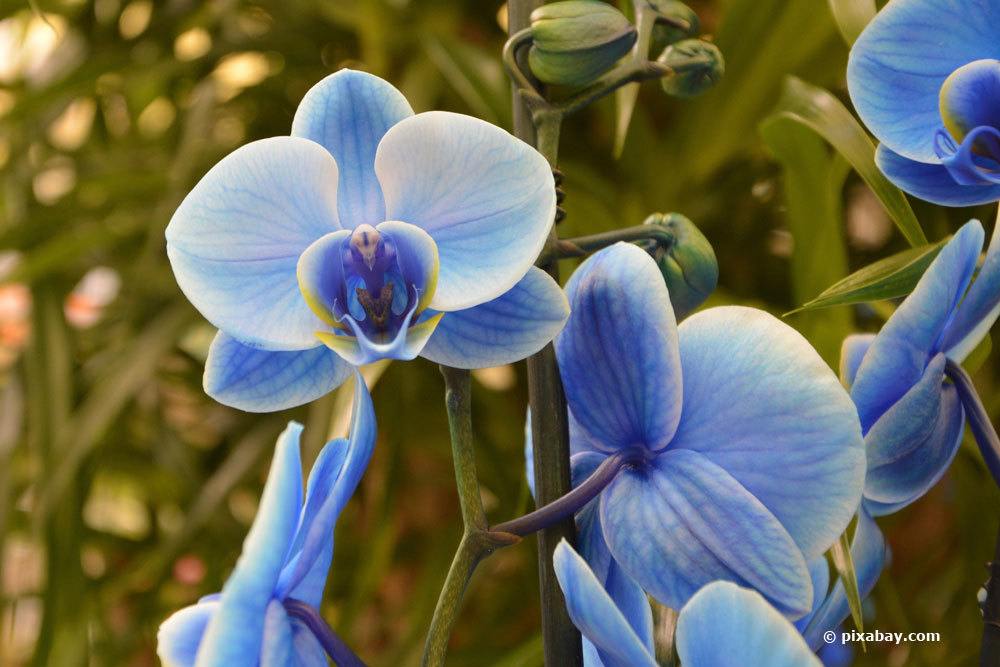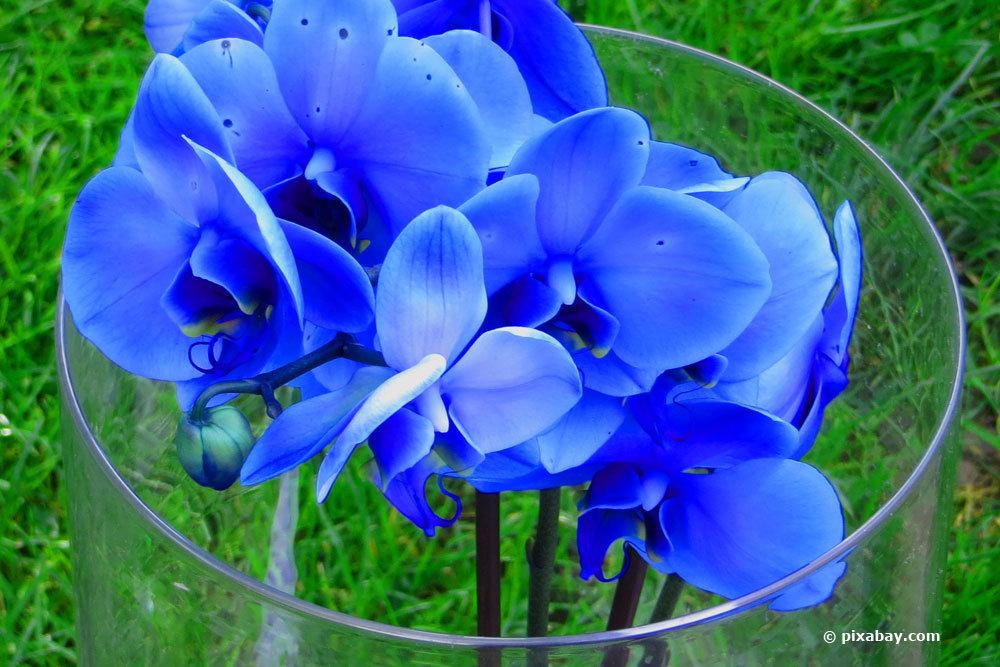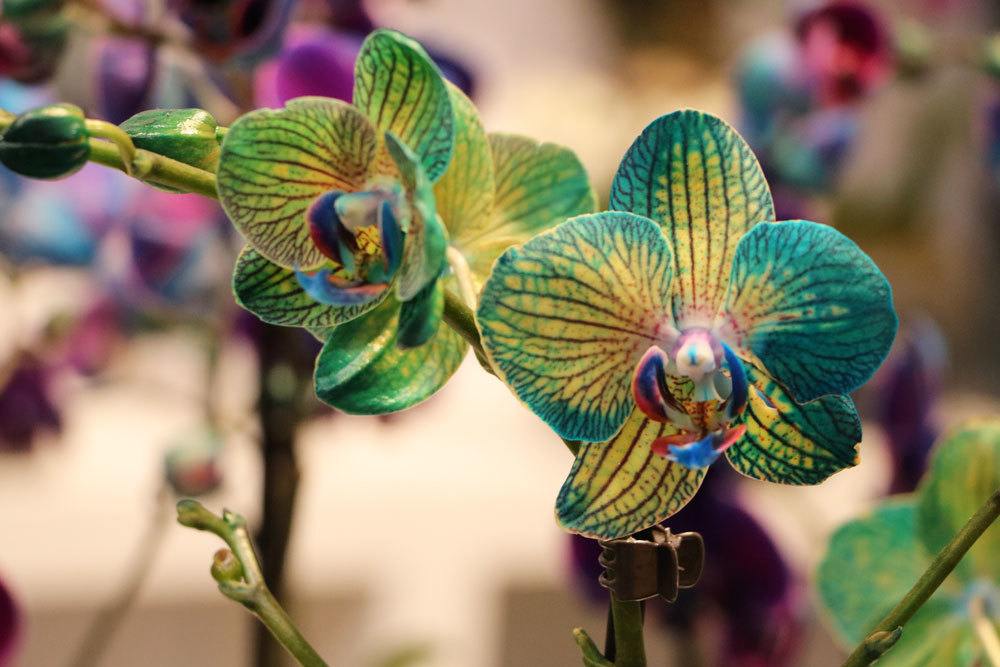Blue orchids are artificial for some, but for many others a color highlight. They are not naturally bred in blue, but artificially colored. Everything there is to know about it and how you can easily dye your orchid blue yourself, explains the plant expert.
Contents
Orchids
The delicate orchids in white, shades of pink and lilac are usually rather inconspicuous in color. If you want to change this and set a strong color accent with your orchid plant, you can now get it in blue. Price-wise, they are in the trade usually significantly above the uncolored orchids and a guarantee that the color will last long and remain strong, you also do not get. But you can also easily dye your specimen yourself or recolor dyed plants from the trade.
Grower orchids
Blue is a very popular color, which is used especially often at home in the furnishing and / or decoration. So such a noble flower as an orchid plant in blue is particularly well received by flower lovers. This has recognized the dealers and short-lived boom of the rose dyeing, now also found ways to dye the delicate Orchidaceae.
Dyeing
The cheapest option used by growers is simple dyeing. This produces different shades of blue, ranging from a bright, strong blue to light blue and turquoise. Reputable dealers use non-toxic dyes. Unseriöse not infrequently resort to a simple spray can from the hardware store. In terms of price, they are usually a few euros higher than the uncolored copies.
Inject
More expensive goes along with a coloring technique, which comes from the hands of a Dutch breeder, who has applied for a patent on it. The blue dye is injected into the conduits of the flowers. A special type of dye is used for this purpose, for which the patent is also in process. However, other colors can also be used for imitation.
On the European flower market, the very popular Phalaenopsis is often offered, which sometimes costs only a few euros, and for plants injected with blue color, customers are asked to pay 30 to 50 euros. Other varieties are also available, such as Anthurium andreanum or Euphorba pulcherrima, which are in about the same price range.
Durability
Injected color
Injecting blue color has a significantly longer or safer shelf life. Once injected into the pathways, it does not weaken due to external influences, as can be the case with the dyed specimens. The durability principle can be roughly compared with hair coloring and hair tinting, whereby flower coloring is equated with hair tinting, because the latter can be slowly washed out by water, while hair coloring only grows out with new hair, which in the case of flower coloring occurs with new flowering.

Coloring
Orchids thrive only in a warm and humid microclimate. This is simulated by appropriately special planters, the special design of which allows moisture to rise continuously up to the flowers. Depending on the quality of the coloring of the flowers, it often happens that an initially strong blue has faded significantly after a few days and may have disappeared completely until wilting.
Others, however, fade only slowly due to the continuous supply of water. In this case, the blue dye is increasingly diluted with water, so that the color intensity decreases. The fact is, however, that in both process techniques the color generally persists at most only for the existing bloom. As soon as a new bloom appears, it will naturally match its original color.
Spray dyeing
Dyeing with a spray bottle is difficult because moisture on the flowers mainly beads off and therefore does not last. Some dubious dealers/breeders therefore roughen the petals or put a layer of wax over them so that the color is accepted. Unfortunately, this is only superficially the case and prevents the colored flowers from growing. In addition, the spray paint, as well as a pre-treatment, damages the plant. Chemical paint penetrates into the interior of the plant and destroys the flower.
Therefore, do not spend money on an orchid with spray coloring and also refrain from trying to do it yourself at home. Chances are that if you do, you won’t enjoy it for long and will eventually have to dispose of it in the trash.
Do it yourself
It is often impossible to find out which dyeing technique has been used on a commercial orchid unless you buy directly from a reputable grower.
Therefore, if you buy a blue version, you do not know whether it will still be blue next week or whether the whole plant is still alive at all. Therefore, with the yet usually somewhat more expensive orchids, it makes sense to do it yourself, so you know what to expect. For coloring you have several options, as they also use serious growers.
Color injection
Not quite so uncomplicated is the coloring after the development of the Dutch breeder and the injection of color, if you are not a nurse / nurse.
For this you need the following accessories:
- Injection container
- infusion set
- blue water soluble food coloring
To dye, proceed as follows:
- Fill food coloring into the infusion bottle – dilute with water if necessary
- in the case of powder, dissolve in water beforehand according to the manufacturer’s instructions
- The food coloring must be thin enough to flow through the hole in the injection needle.
- hang the infusion bottle next to the orchid with the opening facing downwards and upwards
- ideal is a suspension point that is above the plant (more flow pressure)
- Insert the injection needle with the pointed side down into a flower shoot
- Do not pierce the stem
- fix the infusion needle to the flower stem
- Insert the other end of the infusion set into the infusion bottle
- turn the wheel on the infusion set at least one full turn
- optimal time for dyeing: as soon as buds appear
Watering staining
The coloring of irrigation water is quite simple. Here either blue food coloring or ink is used, which is filled into the water container with each watering. In this way, the blue color is slowly absorbed through the roots into the interior of the plant. Stems and other parts of the plant except the flowers, are not dyed blue because the green contrast is too dominant.
However, a little patience is needed for this method, because the plant absorbs the color only with the respective amount of watering water without being able to soak up bulging with it as well as a part of it lands in the water reservoir and evaporates there.
Water bath coloring
In a water bath, the orchidaceae takes on the color faster than with the watering technique. Here, a water bath is prepared vigorously with blue dye. Again, ink and food coloring are the first choice.
How to proceed:
- Take the orchid out of the planter
- put it in the water bath
- without culture pot the plant absorbs the color even faster/intensively
- Roots should be completely immersed in the water bath
Waiting time: depending on the size of the plant and the desired color intensity, three to five hours.
when the desired color shade is achieved, drain the plant well and re-pot it

Vase coloring
Similar to the water bath coloring works the vase coloring, which is especially suitable for cut orchid flowers. To do this, simply fill the vase with blue ink or food coloring and distribute it well in the water. Now, via the flower stem, the color gets into the petals, where they quickly reveal the coloring. While a cut orchid flower stalk placed in pure water, after a few hours usually results in a hanging flower head, experience with colored water has shown that the flower remains upright for days in it. There is no scientific explanation for this so far, but in practice it has been proven several times.
Immersion dyeing
An alternative to the above-mentioned dyeing methods may be immersion dyeing. Here, too, a water bath is prepared with ink or food coloring and the orchid is dipped either upside down or only with the flower. The disadvantage here, however, is the inconvenience as well as the long wait for the petals to take on the color. The latter also happens only to a minimal extent, so that a strong blue is usually not achievable with this method. A delicate pastel tone is more obvious here.
Dyeing material
As already described under “Spray dyeing” in the section “Durability”, spray dyes are in no way suitable for dyeing orchid flowers. But also other types of colors are not necessarily recommended or do not bring the desired effect.
Watercolors
Water-based dyes are not suitable for dyeing orchid flowers in water baths, pots and vases, as they do not provide sufficient color intensity to achieve a satisfactory coloration. Brushing watercolors on the flowers will not succeed on the smooth leaf surfaces. The color would bead off. Only a dip in a highly concentrated watercolor solution could bring at least a little color to the petals.
Food coloring
Blue food coloring is most optimally suited for coloring the petals. It is advisable to prefer liquid products over powder here, as depending on the product quality, it may not dissolve completely and fine granules could possibly clog the narrow life paths in the stems. This would not only prevent flower coloration, but also cause life-threatening damage to the orchid, as no nutrients or moisture could reach all parts of the plant through these pathways either. Food coloring is basically toxin and pollutant free, so it will not affect plant life or functions.
Ink
Care should be taken when choosing ink for an orchid dye job, as there are several types of ink, not all of which are well tolerated by the delicate flower.
Printer ink
Printer ink, or inkjet ink, usually has dyes in it that are not usually subject to harmlessness testing. In addition, it contains chemicals so that, for example, printer heads do not clog and dries quickly on paper. Orchid plants can react very sensitively to these chemicals. For this reason, printer ink should not be used to dye flower blossoms.
Writing ink
The situation is different with water-based ink, such as that used for fountain pens and writing on paper. These are usually non-toxic and free of harmful chemicals that the Orchidaceae may not tolerate well. In a few exceptions, there are mildly irritating preservatives in them. Here you should go for a branded product such as Pelikan or Lamy to ensure that no irritant substances are included.
Solvent ink
Solvent ink, also known as solvent ink, would be ideal for spraying or dip dyeing if it were not for the solvents it contains, which make this ink suitable for coloring smooth surfaces. Solvent ink is known, for example, as stamping ink or for marking glass or foils. However, the ingredients such as ethanol, alcohol, isopropanol, methyl ethyl ketone or ethyl acetate are not suitable for entering the supply cycle of a sensitive orchid plant. Here it is absolutely advised: Keep your hands off solvent-based inks!


